How to fish the Sea Trout Pool on the Welsh Dee at Llangollen
Table of Contents
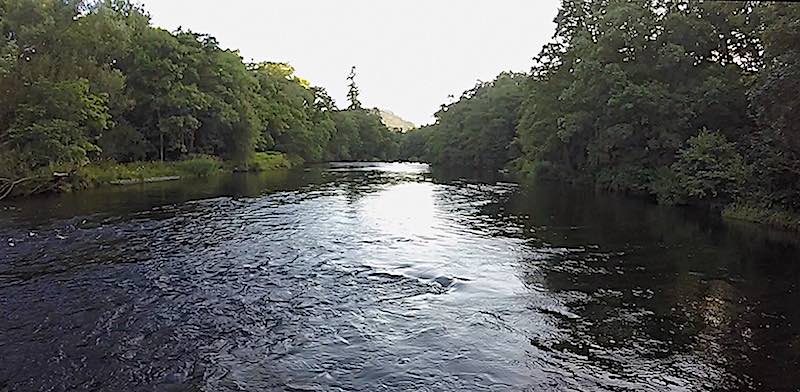
Sea Trout Pool Introduction
The Sea Trout Pool is another of my favourite pools on the Welsh Dee above Llangollen. Its name suggests that sea trout are the main quarry, however, the pool holds a good head or grayling and some decent brown trout.
Accessing the pool is difficult but it’s well worth the effort because the fishing there is often very good.
Unfortunately, it cannot be fished from the bank because both banks are overgrown with bushes, etc. Therefore, the only option is to wade from the right bank but fortunately, the riverbed is composed of gravel and small boulders.
I only fish the sea trout pool when the river is close to its summer level (less than 0.6m @Manley Hall gauge) and running clear.
There is a problem with canoeist on this section of the Welsh Dee, especially, during the summer months. Therefore, I normally fish this pool early morning or after 6 pm.
Fly fishing for trout & grayling:
I have had some fantastic catches of grayling and trout fishing the sea trout pool during the summer months and it’s not uncommon to catch more than 10+ fish in a short session.
On a recent memorable July evening, I had in excess of 40 grayling and a stunning brown trout in 2hrs while fishing a team of wet flies. Nearly every cast produced a fish.
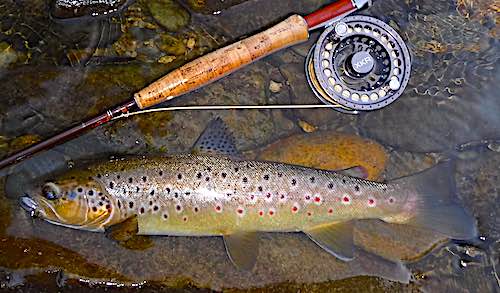
The Welsh Dee flows east through the sea trout pool and the wooded right bank casts some shade onto the river until late morning during the summer. After which, the fishing usually slows until late afternoon.
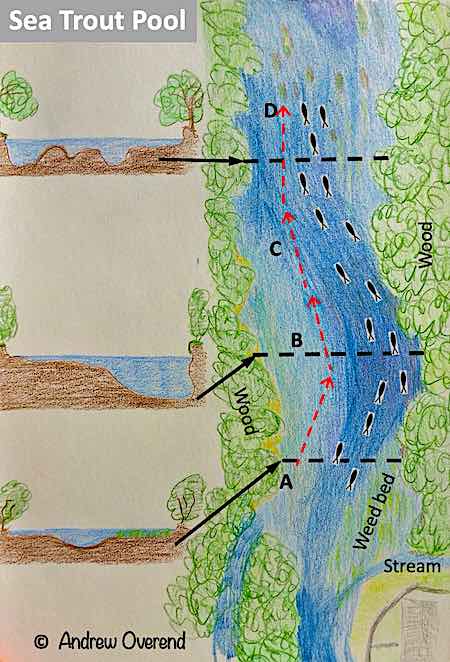
In this sketch of the Sea Trout Pool, I’ve highlighted where I usually catch grayling and trout when the river is at its summer level.
In the tail, zone A to B, the fish lie close to the edge of the weed-bed on the far bank, which extends into the deep hole.
From B to D, grayling lie in the main channel and over to the far bank. Trout tend shelter close to the far bank.
Grayling move around this pool and therefore, it is often worth fishing the whole pool, even the very shallow sections.
The red dotted line on the sketch highlights the route I usually wade when fishing this pool (summer level only).
At point D, it is not possible to wade back to the right bank because the rock outcrop has cut a deep channel close to the right bank. Therefore, I normally switch to fishing nymphs or wet flies back to the tail.
Dry Fly Fishing the Sea Trout Pool:
If trout and grayling are rising, dry fly fishing is my preferred mode of attack. I will fish the pool from A to D, roughly following the red dotted line, while keeping as close to the right bank as possible.
For fly selection, it’s best to match the hatch but if this isn’t possible at the end of this section there are some fly recommendations for each month of the year.
If I spot a grayling rising close to the far bank, I usually avoid casting directly to it. Instead, I first make a couple of casts to cover the main channel because this can yield additional grayling, which would have otherwise been spooked.
The zone of fast water (C to D) usually holds a few grayling and the odd trout.
It’s sometimes difficult to see rises in the fast water; therefore, methodically fish this area from the right to left bank as you move slowly to point D.
On reaching point D, I often sit the rock outcrop close to the right bank and rest the pool while switching over to fishing a team of wet flies or nymphs, before fishing back into the tail.

Wet Fly Fishing the Sea Trout Pool:
If trout and grayling are feeding close to the surface I will fish through the sea trout pool with a team of wet flies or North Country spiders.
My approach is to cast the wet flies upstream at about 45 degrees and allow them to dead drift downriver before the swing around to the dangle. When the flies drift downstream of me, I mend the line to slow the swing to the dangle.
When it’s not possible to identify what flies are being taken, I will start with one of my workhorse team of wet flies /spiders spaced 3ft apart on 3lb copolymer leader, depending on the time of year.
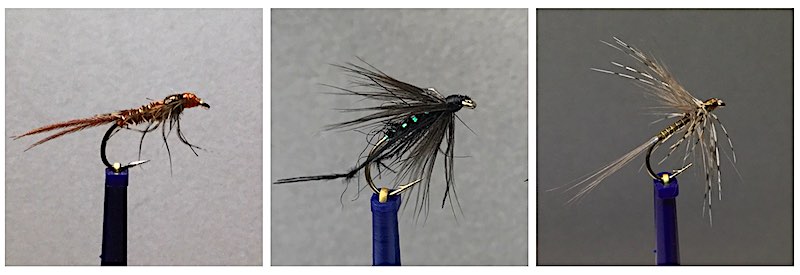
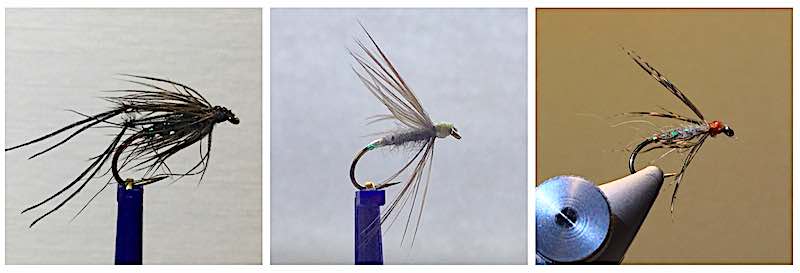
If after 15 – 20 minutes, I haven’t had any takes, I start trying other patterns until success comes. That said, the workhorse teams rarely fail to catch grayling and trout. More information on fly choice for each month of the year is outlined below.
In addition, I have a separate page on Wet Fly fishing that has more information on the approach I find successful.
Euro/Czech nymphing the Sea trout Pool:
On cold days, when there is no visible fly life activity, it is usually best to search the river bed with a team of nymphs. Since grayling & trout are likely to be grubbing on the riverbed for food.
Nymph selection depends on a number of conditions that are covered in the nymphing technique page. Below is a typical example of a team of nymphs I will use when the river is running clear.
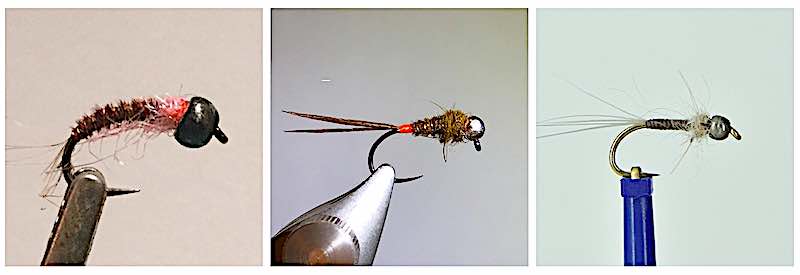
How my approach changes with the season:
Fly fishing Sea Trout Pool in March:
The brown trout fishing season on the Welsh Dee starts on the 3rd March. However, the weather in March is often more like winter than spring.
On mild days, hatches of large dark olives and March Browns usually start around 11 am and you will often spot trout picking them off as they drift through this pool. During these hatches, my approach is to target the rising fish with the dry fly (large dark olive or March Brown pattern).
For more information on the fly selection for fishing during March check out the following article:
Fly fishing the Sea Trout Pool in April:
In April, the weather starts to warm up, and hatches of Large Dark Olives, March Brown, Grammon, and other olives become more prevalent from mid-morning to mid-afternoon. Hence, providing more opportunities to catch brown trout on the dry fly by matching the hatch.
More information on the fly selection for fishing during April is covered in the following post.
Fly fishing the Sea Trout Pool in May:
As the weather warms and dries up during May, fly hatches become prolific and brown trout become eager to fatten up on the emerging fly life. Examples of flies you will see include:
Upwinged flies:
- Blue winged olive
- Large dark olive
- Medium olive
- Iron Blue Dun
- Pale Watery Dun
- Olive Upright
- Yellow May Dun
Sedges:
- Black sedge
- Grannaom
- Cinnamon sedge
- Medium sedge
Others:
- Hawthorn fly
- Alderfly
- Large stonefly
- Midges
As a result of all the fly-life, May is when dry-fly and upstream wet-fly fishing produce the best catch results, when you have identified which flies the trout are taking.
Even on sunny days, the fishing can be good from morning to dusk, but the best fishing is often in the morning and evening.
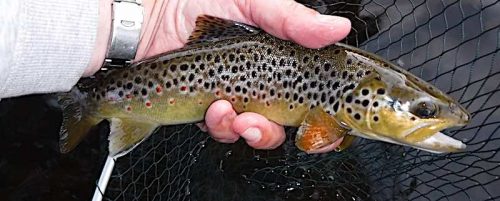
Fly fishing the Sea Trout Pool from June and August:
The head of the pool is a great place to fish in low water because trout and grayling will be lying in oxygenated water. On sunny days, this section of the river will yield trout and grayling throughout the day, but the best fishing is early in the morning and after 5 pm.
More information on summer fly selection is covered in the following posts.
Fly fishing the Sea Trout Pool in October:
My attention turns to grayling fly fishing from October to the end of February on the Welsh Dee.
During autumn and winter, river conditions often dominate my grayling fishing activities. I will only fish this pool if the river is running clear and the level is below 0.55m (Corwen gauge).
During October on the Welsh Dee, fly hatches are still common most days. The flies you are likely to see hatching include…
- Iron Blue Dun
- Pale Watery Dun
- Olive Upright
- Egg-laying Stoneflies
- Midges
On cool October mornings, fly hatches don’t start until mid-morning. Therefore, I wait until flies begin to hatch before fishing the sea trout pool with the dry fly or Klink & Dink.
Ideally, it’s best to identify what flies that are being taken and then tie on a suitable imitation.
If it’s not possible to identify which fly is hatching, I start with a CDC olive emerger pattern that has served me well in the past. When that fails, I start working through my fly box. However, it’s rare not to catch a grayling on one of the three dry flies below.
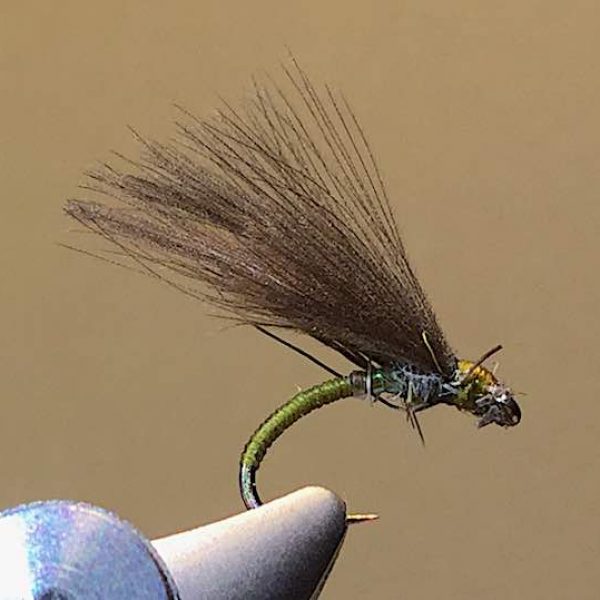
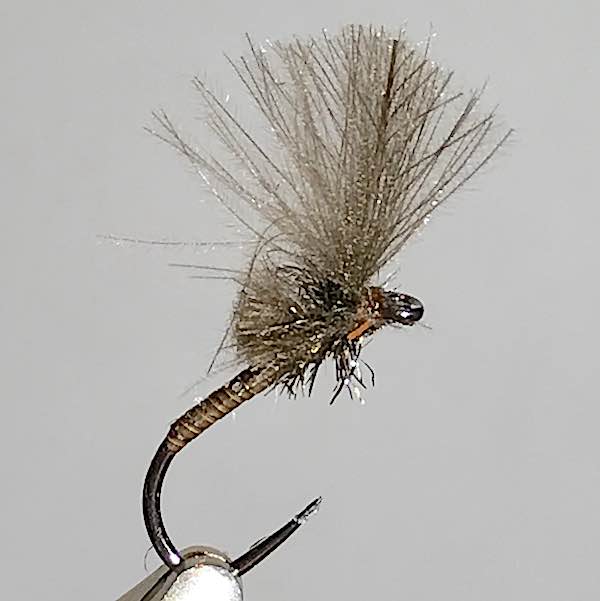

On the rare occasions it’s not possible to tempt grayling with either of the above approaches, it necessary to switch to fishing nymphs close to the riverbed.
Check out the link below for additional reading on flies for October:
Fly fishing the Sea Trout Pool from November to February:
The clocks go back at the end of October and the days get increasingly shorter during November. At this time of year, the river is often too high to fish the Sea Trout Pool.
With limited daylight hours, I focus on pools that fish well in high water and where grayling are beginning to shoal. For example, Horseshoe Falls, Duncan’s Pool, Pipe Pool, and Dee Farm.
For more information on the flies to use during winter check out the following articles…
Fly Fishing for sea trout:
As it name suggests, this pool is a classic sea trout pool consisting of a gravel bottom, shallow right bank and a deep undercut left bank that offers shelter to resting fish, that are waiting to ascend Abbey Brook to spawn.
I must stress that if you have any apprehension of fishing at night then don’t fish this pool after dark. It’s not a pool to start learning how to fish for sea trout at night or fish alone at night.

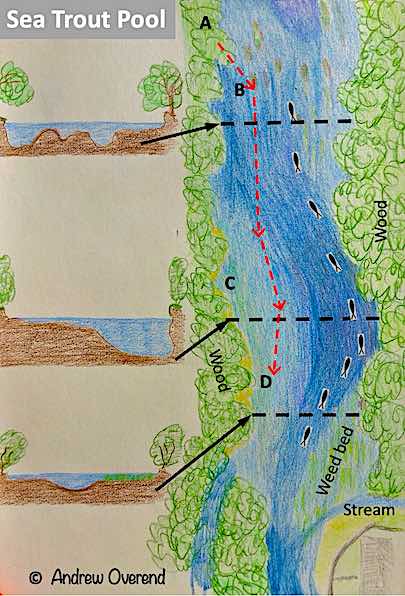
I’ve produced this sketch to share how I normally fish this pool for sea trout when the river is below 0.5m @Manley Hall gauge.
Usually, I wait until it’s almost dark before accessing the river at point A on the map, which is the tail of Ty Craig Pool. Then I carefully wade down to the rock outcrops at B and sit there until it’s dark enough to start fishing.
From point B, I fish across to the rocks close near the far bank where a few small sea trout are found.
After every cast, I take a step downriver and recast, while roughly following the route marked by the red dotted line. Sea trout often follow the fly round from the far bank, so don’t recast too quickly.
Bigger sea trout lie in the deep water near the far bank between points C to D.
Near the tail of the pool, I’ve been broken by a couple of very big sea trout that I tried to stop heading off downriver into the next pool.
Each year, winter floods move the gravel around in this pool and the main channel changes its location. Therefore, I always fish this pool during the day to find the best wading path before fishing at night.
Some years the channel at B is too deep to wade. When this happens I will wade upriver from C as far as possible and then fish the pool to the tail.
Flies for Welsh Dee sea trout:
Most of the standard sea trout flies will work on the Welsh Dee. However, to get you started below are a few examples that I’ve caught Welsh Dee sea trout on:
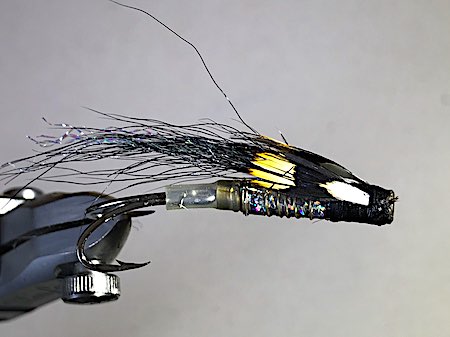
Silver Stoats - 25mm tube
- Tube – 25mm (copper, Aluminum, plastic)
- Thread – black 6/0
- Body – silver holographic tinsel
- Rib – silver wire
- Underwing – crystal flash (3 strands)
- Wing – black squirrel
- Jungle cock
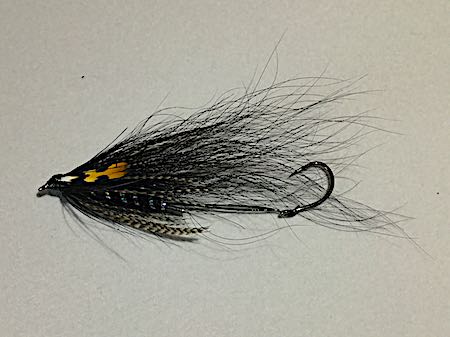
Black & Silver Singer
- Hook shank – 32mm OPSJ 116 series
- Hook – #6 Partridge Inbtruder Z4
- Thread – black 6/0
- Body – Black floss
- Rib – medium silver tinsel
- Wing – black squirrel
- Hackle – teal feather
- Jungle cock
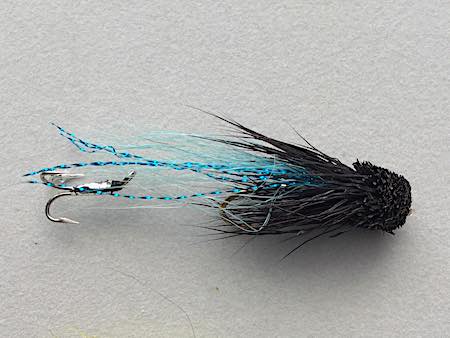
Jumbo Blue Muddler
- Hook – #6 Kamasan B800
- Hook – #14 treble on 18lb nylon
- Thread – black 6/0
- Body – Black floss
- Rib – medium silver tinsel
- Wing – blue bucktail & crystal (3 strands)
- Head – black Deer hair clipped
How to get to the Sea Trout Pool:
From Llangollen take the A5 to Crown then just after the junction with the B5103 by Berwyn Station take the next right and park by the railway.
The sea trout pool is accessed by walking down the path under Berwyn Station, passed the Chain Bridge. and down through a wooded area to the right bank of the pool. A map to this pool can be found on Llangollen-Maelor Angling website.
Disclaimer: Fishing, like most outdoor sports, is not without its hazards. Therefore, YOU MUST DO YOUR OWN RISK ASSESSMENT before starting to fish the Sea Trout Pool. Especially if you decide to wade and/or fish at night. In addition, you must follow the Llangollen-Maelor Club Rules when accessing and fishing this water.